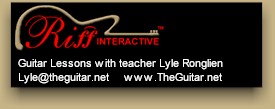Scroll through the lesson and click on notation/video/audio links to load the interactive players.
Please subscribe to get full access to all lessons for only $7.95/month PLUS 1 week free trial.

Riff Interactive lessons are
LESS expensive and
MORE interactive than alternatives!
More Info
|
|

Jam Sessions - Rock
Style
Lesson 2 - Jam in G
Lyle: Key of G for this lesson.
Here's your jam track:
chord chart

Lyle: These lessons are great for the student who
is looking for new things to practice, new theory to apply, new ways to
improvise using modes, and perhaps best of all, something new to jam to.
Lyle:
There's not a chord during the groove of this jam track which leaves it wide
open for you to play almost anything! Here's what the bass guitar riff looks
like:
Lyle:
The bass riff is made from the root (G), the b7th (F), and the 6th (E) of the G
scale. Since there's a b7th in the riff, you can treat the groove as if it were
in a minor key. Here's a rhythm guitar riff you can try:
Jamie: It has
an Eddie Van Halen sound to it
Lyle: Yes, that's what I was going
after.
Lyle: Since there isn't any chords in the
background of the jam track, any note can be played as you improvise. Some notes
sound better than others, some sound more exotic than others. Check out the G
chromatic scale here on just the 3rd string:
Lyle:
This scale uses every note available from G to G. Here's an example of me
playing this scale pattern against the jam track:
Lyle:
Remember, some notes sound like they fit better than others. You have to develop
a taste for some of the "odd" sounding notes!
Lyle:
Try playing this scale against the jam track. Listen to each different scale
degree and how it sounds to you. Here's another way to play the chromatic scale.
This is a riff from the lesson sample.
Lyle:
There's no wrong notes! They all work! Here's another way of playing the
chromatic scale, this time up the 2nd string and doing a unison bend with each
note:
Lyle:
Near the end of the lesson sample there's a harmonic/pull-off riff. Here's how
to do it. Have your left hand play this over and over real fast:
Lyle:
Then drag your heal of your picking hand over the 3rd string like this:
Dave: Lyle...is
this more a major pentatonic scale...I mean the notes you mention with the
harmonic riff?
Lyle: Those notes are just random, and something
to make harmonics with.
Lyle: Those would be notes from the G Major
scale.
Frank:
Lyle, what are you doing with your pick hand?
Frank: Just sliding up the
frets?
Dave:
Palm harmonics.
Lyle: Yes, good way to call it, palm
harmonics.
Lyle: Next I'd
like to show you a few more scale choices to play against this jam track. The
first choice has to be the G minor pentatonic:
Lyle: Here's another scale you can use
to improvise with:
Lyle: The G Dorian minor scale fits
well against the jam:
Dave: Can you add a flatted 5th?
Lyle:
Yes, the flatted fifth is the "blues
note".
Lyle: The reason that the G Dorian minor works is
because the bass riff in the jam is made from 3 different notes, G, F, and E
which are the root, b7, and 6 in the key of G. The G Dorian minor scale has
those scale degrees in it.
FireWookie: The Dorian is just a bit more subtle than
the blues riff
Lyle: Same thing goes for the G Mixolydian scale:
Lyle:
Another scale I like to use is the G Phrygian Dominant:
FireWookie: The
Mixolydian sounds a little more major than the
Dorian...
Lyle: The Mixolydian is just like a Major scale
but with a flatted 7th.
FireWookie: Nice Lyle, I like that one. Very middle
Eastern
Lyle: Be sure to "listen" to the audio in each
tab so you can hear how the scale sounds against the jam track.
Lyle:
Now you have a bunch of scale options to try against the jam
track.
zz: How
about using the arpeggios...any
suggestions?
Lyle: Yes, G major and Gm would
work:
Lyle:
That's all for this jam session.
Lyle: Also the jam tracks from this lesson are
available in high quality MP3 download from my website. Email me for details:
Lyle@theguitar.net
|
<< load notation from left
|
|
<< load audio from left
|
<< load audio from left
|